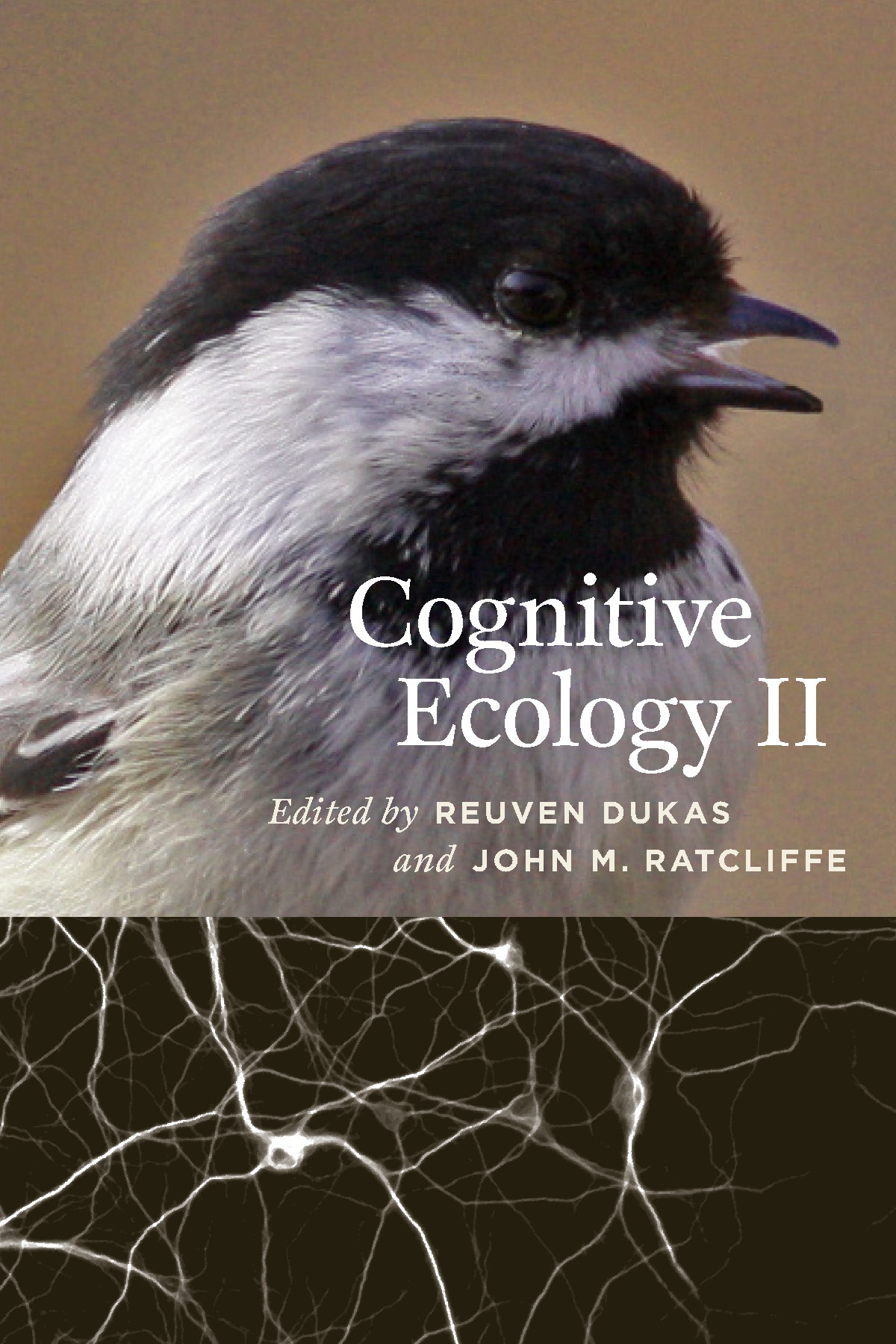

HOME | Lab members | Research projects | Prospective students | Publications | e-mail | Links
COGNITIVE ECOLOGY II
Edited by
REUVEN DUKAS and JOHN M. RATCLIFFE
2009
The University of Chicago Press
Order from Chicago, Amazon USA or Amazon Canada
1. Introduction
REUVEN DUKAS and JOHN M. RATCLIFFE
PART I LEARNING: ULTIMATE AND PROXIMATE MECHANISMS
2. Learning: Mechanisms, Ecology and Evolution
REUVEN DUKAS
2.1 Introduction
2.2 What is learning?
2.3 Why learn?
2.4 Who learns?
2.5 What do animals learn?
2.6 Is learning important?
2.7 Prospects
3. The How and Why of Structural Plasticity in the Adult Honey Bee Brain
SUSAN E. FAHRBACH and SCOTT DOBRIN
3.1 Introduction
3.2 The honeybee as a model for the study of neural plasticity
3.3 Mushroom bodies: neuroanatomy
3.4 How does foraging experience change the structure of the honeybee mushroom bodies?
3.5 What is the function of the honeybee mushroom bodies?
3.6 Why are the mushroom bodies larger in experienced foragers?
3.7 Studies of experience-dependent plasticity in the mushroom bodies of other insects
3.8 Specific future directions
PART II AVIAN COGNITION: MEMORY, SONG AND INNOVATION
4. More on the Cognitive Ecology of Song Communication and Song Learning in the Song Sparrow
MICHAEL D. BEECHER and JOHN M. BURT
4.1 Introductions
4.2 Background
4.3 Song learning in the field
4.4 Communication by song in male-male interactions
4.5 Social eavesdropping hypothesis
4.6 Discussion
4.7 Summary
5. Consequences of Brain Development for Sexual Signaling in Songbirds
WILLIAM A. SEARCY and STEPHEN NOWICKI
5.1 Introduction
5.2 The song system
5.3 Female preferences for song attributes
5.4 Experimental tests of the developmental stress
5.5 Effects of developmental stress on phenotypic quality
5.6 Conclusions and prospects
6. Development of Spatial Memory and the Hippocampus under Nutritional Stress: Adaptive Priorities or Developmental Constraints in Brain Development?
VLADIMIR V. PRAVOSUDOV
6.1 Introduction
6.2 Spatial memory and the hippocampus in birds
6.3 Nutritional deficits during post-hatching development, spatial memory and the hippocampus in western scrub-jays Aphelocoma californica
6.4 Nutritional deficits during postnatal development and the hippocampus in mammals
6.5 Hippocampus and song brain nuclei in birds
6.6 Does lack of nutrition directly cause changes in the brain?
6.7 Stem cells
6.8 Conclusions
7. The Cognitive-Buffer Hypothesis for the Evolution of Large Brains
DANIEL SOL
7.1 Introduction
7.2 Assumptions of the cognitive buffer hypothesis
7.3 Predictions of the cognitive buffer hypothesis
7.4 Synthesis
7.5 Future avenues
7.6 Summary
PART III DECISION MAKING: MATE CHOICE AND PREDATOR PREY INTERACTIONS
8. Cognitive Mate Choice
MICHAEL J. RYAN, KARIN L. AKRE, and MARK KIRKPATRICK
8.1 Introduction
8.2 Detection and perception
8.3 Evaluation and decision
8.4 Conclusions and directions
9. Monogamous Brains and Alternative Tactics: Neuronal V1aR, Space Use and Sexual Infidelity among Male Prairie Voles
STEVEN M. PHELPS and ALEXANDER G. OPHIR
9.1 Introduction
9.2 Reproductive decisions, space use and mating tactics
9.3 Neural substrates of alternative tactics
9.4 Microsatellite polymorphisms and phenotypic diversity
9.5 Monogamy and cognitive ecology reconsidered
10. Assessing Risk: Embryos, Information and Escape Hatching
KAREN M. WARKENTIN and MICHAEL S. CALDWELL
10.1 Introduction
10.2 Cognitive strategies to assess risk using non-stereotyped cues
10.3 Adaptive responses of embryos in heterogeneous environments
10.4 Hatching decisions: information use by red-eyed treefrog embryos
10.5 Conclusions and future directions
11. Predator-Prey Interaction in an Auditory World
JOHN M. RATCLIFFE
11.1 Of bats and moths and coevolution
11.2 Sensory ecology and foraging strategies of predatory bats
11.3 Auditory-evoked defensive behaviors in noctuoid moths
11.4 Bat detection and the primary and secondary defenses of moths
11.5 Summary and conclusions
11.6 Future directions
PART IV COGNITION AND SOCIALITY
12. What do Functionally Referential Alarm Calls Refer to?
MARTA B. MANSER
12.1 Introduction
12.2 Meerkat alarm calls
12.3 What do functionally referential alarm calls refer to?
12.4 Why are some alarm calls considered functionally referential and not others?
12.5 Functionally referential calls explained by emotional expressions of the signaller?
12.6 Conclusions
12.7 Summary
13. Adaptive Trade-Offs in the Use of Social and Personal Information
RACHEL L. KENDAL, ISABELLE COOLEN, and KEVIN N. LALAND
13.1 Introduction
13.2 “When” Strategies
13.3 “Who” Strategies
13.4 Evolutionary Implications
13.5 Summary and Future Directions
14. The 3E’s approach to social information use in birds: ecology, ethology and evolutionary history
IRA G. FEDERSPIEL, NICOLA S. CLAYTON, and NATHAN J. EMERY
14.1 Introduction
14.2 Case studies
14.3 Conclusions
15. Prospects
REUVEN DUKAS and JOHN M. RATCLIFFE
Updated August 17, 2009 09:30 PM